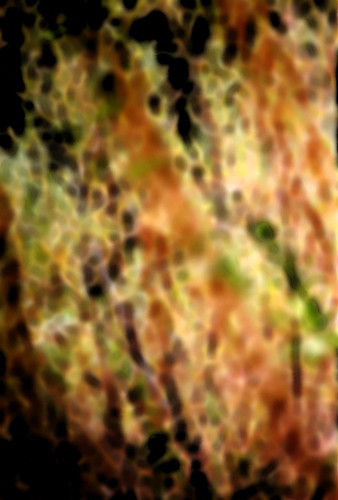Color Field Imagery, the Emotions, and Me
While perusing the thousands of photos on my hard drive some months ago, it struck me that most of them attempted little more than to document, clearly, a person, place, or event. If art has anything to do with expressing one's perceptions, these images were far from art. At best, they were documentation.
Those shots serve their purpose: prompting a failing memory. But they did not serve the needs of my heart, mind, or gut. I'd kept a lid on the Roiling Cauldron of my soul for a long time, and it needed a vent. I started writing. I started making little tunes, but the soul wanted to express in images as well.
I wanted to find ways to use cameras to make images that expressed feelings and perceptions directly, the way music does, or the way poems do. I was done with photo documentation, but how could I use the camera in other ways?
For a while I shot only textures and patterns, and found that textures and patterns can move me in the way rhythm moves me. A well-composed shot of a pattern or texture can express perceptions of pulse, beat, cadence, synchronicity, or syncopation. When I first saw Piet Mondrian's
Broadway Boogie Woogie, I wanted to tap, no stomp, my feet to it. It made me want to dance. Photos capturing the choreography of trees in a wind, or the rippling waves of a large flock of birds in flight also can set feet, hands, head--the whole body--into motion.
While out shooting patterns one day, however, it struck me that I was obsessed with focus, with clarity. Using cameras itself enhances this bias. Lenses and high-resolution recording media are designed to capture sharp, detailed, realistic images. That's what photos are, isn't it? "It looks just like the real thing," is a common compliment to a good photo. In fact, wasn't the creation of the camera in some way responsible for the trend among painters, starting sometime in the early 20th century, to move away from realism toward abstraction and expressionism? No-one's draftsmanship can compete with a camera's. What of it? Artists raised abstract images that questioned, strongly, whether realistic depiction were the primary purpose of art anyway.
The aforementioned Roiling Cauldron wanted something different from the camera. It did not want realism. Why not turn the camera inside out, and try to discover ways to make abstract images, instead of realistic images, with it? I set about using the camera to make images in which the subject is unrecognizable, or nearly unrecognizable. I intentionally under-exposed, over-exposed, and--most importantly--de-focused, in order to find (through the lens) hazy clouds of colors arising from one another, blending with one another. Finding these clouds in the world around me was deeply satisfying. If pattern and texture were rhythm, color clouds were timbre, harmonic euphony and dissonance. The Cauldron had found a new vent. I made some images like

and showed them to an artist, my sister
Christine. She said, "These remind me of some of the
Color Field work of Jules Olitski."
I took a look, and yes indeed, the Cauldron liked these very much, especially Olitski's blurry pieces, like
Draky,
Comprehensive Dream,
By Love Unlocked: Beauty, and
Moses Path - Lavendar and Green. I leave you to find the last two paintings mentioned for yourself on the Late Work page on the
Jules Olitski site.
Olitski's site mentions an exhibition that traveled the U.S. back in 2007-2008 called
Color As Field: American Painting, 1950-1975. The description of the exhibition lists the artists whose color field works were included. If you want to know who they were, click Exhibitions on the Jules Olitski home page, and scroll to the bottom of the exhibitions page to find
Color As Field: American Painting, 1950-1975.
 and showed them to an artist, my sister Christine. She said, "These remind me of some of the Color Field work of Jules Olitski."
and showed them to an artist, my sister Christine. She said, "These remind me of some of the Color Field work of Jules Olitski."